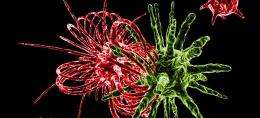Virus 'barcodes' offer rapid detection of mutated strains

Researchers at the University of Leeds are developing a way to 'barcode' viral diseases to rapidly test new outbreaks for potentially lethal mutations.
Dr Julian Hiscox and Dr John Barr of the University's Faculty of Biological Sciences are working with the Health Protection Agency Porton (HPA) to build a bank of molecular signatures that will help identify the severity of virus infection from characteristic changes seen in cells. Currently the team is barcoding different strains of influenza virus and human respiratory syncytial virus (HRSV) - a virus associated with the onset of asthma in young children.
"Diseases such as flu infect and hijack our cells, turning them into virus producing factories," says Dr Hiscox. "The infection causes the balance of proteins in a cell to change - some proteins are overproduced and others suppressed. Which proteins are affected and by how much varies depending on the type of virus, allowing us to identify a unique barcode of disease for each."
The research, published today in Proteomics, investigates changes in lung cells infected with swine flu from the 2009 outbreak compared with seasonal flu. The team used a labelling technique called SILAC to measure and compare thousands of different proteins in a sample.
This technique was used alongside mass spectrometry to identify the proteins most affected by viral infection and used these as molecular signatures to provide the 'barcode' of disease. The paper reports how several processes in the cell were affected by the virus, with most changes seen in proteins involved in cell replication.
"Swine flu affects the lungs in a similar way to seasonal flu and this was reflected in the barcodes we found for each," explains Dr Barr. "Using this test might have been a way to identify how lethal the 2009 swine flu pandemic was going to be, lessening worldwide panic.
"Our next step is to test more lethal strains of flu, such as bird flu, to see how the barcodes differ. Flu virus frequently mutates, resulting in new strains which may be life-threatening and become pandemic. If we can test new strains using our method, we can determine their potential impact on health by comparing their barcode of disease to those of viruses already studied."
The group from Leeds has already barcoded two types of HRSV which can cause severe respiratory disease in young children. Co-author Professor Miles Carroll of HPA Porton says: "We have focused our work on common respiratory viruses, such as flu and HRSV, but this method could be applied to a wide variety of viruses, including tropical diseases that are prone to sudden outbreaks and can be lethal."
More information: The study, titled A quantitative proteomic analysis of lung epithelial (A549) cells infected with 2009 pandemic influenza A virus using stable isotope labelling with amino acids in cell culture (SILAC) is published online by Proteomics, DOI: 10.1002/pmic.201100470
Provided by University of Leeds
















